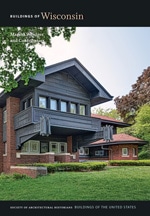
This impressive Tudor Revival church has an unusual U-shaped plan. Its western leg is a monumental three-story nave, clad in irregular, randomly laid stone. The nave’s front-facing gable embraces a generous Tudor-arched window filled with tracery and stained glass. On the nave’s west side on 5th Street, narrow Gothic windows alternate with stone buttresses. At the southeast corner, a blocky three-stage tower rises to a crenellated parapet and a spire. Inside the nave, great oak trusses spring from stone corbels to support a wood-paneled ceiling, and dark hand-carved oak lends strength to the choir loft, pews, and altar. In contrast to the stone nave, the front-gabled parish house, which forms the other leg of the church’s U-shape, is built of stone at ground level, but the overhanging second and attic stories have false half-timbering. The wing linking the parish house to the nave continues the half-timbered theme in its narrow, steeply pitched gabled wall dormers.














